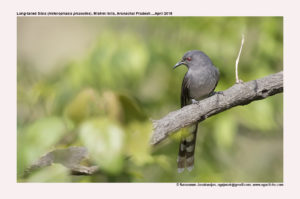Long-tailed Sibia

Long-tailed Sibia Heterophasia pulchella
Etymology :
- Heterophasia : Greek word heteros- different; phasis- Appearence
- Pulchella : Latin word for “very beautiful” derived from pulcher –beautiful
Distribution in India: Resident of Eastern Himalayas and hills of North East India.
Description: Size of 28–34·5 cm; Wt. of 40–46 g. It is a grey babbler with very long, whitish-tipped tail, white wing patch, and rather long, narrow and slightly decurved bill. The nominate race has crown and upperparts as darkish grey, upperwing is brownish-slate with white outer fringes of secondaries forming oblong white patch, tail is brownish-slate with broad greyish-white tips. The head side, neck side and chin to breast are mid-grey, shading paler on lower underparts. The iris is red to chocolate-brown, sometimes pale brown; bill is black; legs are dusky grey to purplish-grey. Both the sexes are similar. The juvenile has grey iris, paler legs and feet.
Habitat: It is found in broadleaf evergreen forest, forest edge, and secondary growth, and oak and pine forest, open scrub with large trees or clearings in forest. It is found from 500m up to 3000 m.
Food habits: It eats Insects, flower buds, fruits, berries, nectar and seeds. It occurs in pairs or in small parties, in association with other species in bird waves. It forages mostly in canopy of larger trees, often where foliage quite thin, and also down to lower branches of trees and taller understorey vegetation.
Breeding habits: They breed in Feb–Aug. .The nest is built by both sexes. The nest is a very deep cup or bag, made mostly of moss with some dead leaves, lined with rootlets and rhizomorphs, placed above ground high up on horizontal branch or suspended from thin twigs of tree .